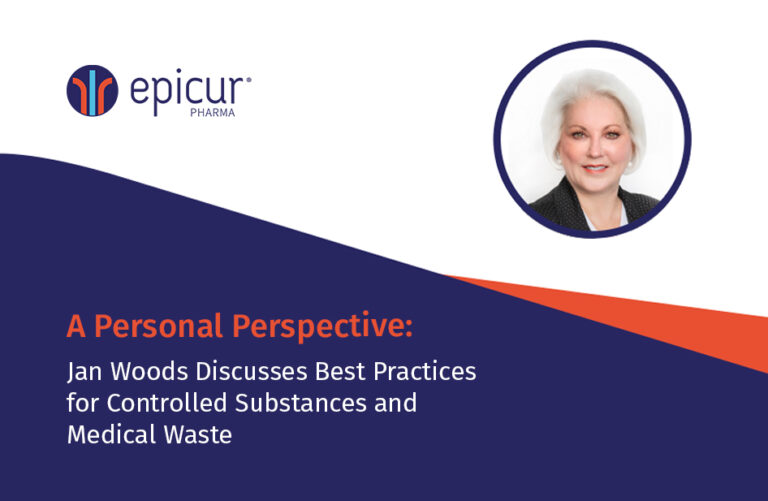The following blog is written by Epicur Pharma’s Advisory Council member Jan Woods, Veterinary Consultant and Co-Founder of Ask Jan For Help. She writes about the common questions she hears from veterinary practices about controlled substance handling and best practices.
From Jan:
One of the most frequently asked questions that I receive is, “How do I destroy my controlled substances?” To answer this question, let’s talk about part of your controlled substance destruction—medical waste. We will define it and examine how it’s to be destroyed to stay compliant with the DEA.
What Is Controlled Substance Medical Waste?
Title 21 of the Federal Regulations, Section 1304.21(e) (paraphrased), defines controlled substance medical waste and its destruction as: “The destruction of a controlled substance dispensed by a practitioner for immediate administration at the practitioner’s registered location, when the substance is not fully exhausted (e.g., some of the substance remains in a vial, tube, or syringe after administration but cannot or may not be further utilized), shall be properly recorded in accordance with §1304.22(c), and such record need not be maintained on a DEA Form 41”. Note, this includes the controlled substances left over in your CRI bags too!
How Do I Destroy My Controlled Substance Medical Waste?
Previously, it was acceptable to dispose of controlled substance medical waste in kitty litter, coffee grinds, down the sink, or flushed down the toilet, but this is no longer allowed. The DEA makes it clear that any controlled substance medical waste not fully exhausted should be placed in a suitable neutralizing material, which is readily available through your distributor or Amazon, and then incinerated.
US Bio-Clean notes, “Although the DEA states that it seeks to determine a variety of destruction methods, the only acceptable method of destruction for pharmaceutical wastage (i.e., drugs dispensed to a patient and not fully used, such as a single syringe with remaining controlled substance) at this time is incineration.”
That means that the only method that currently meets the DEA requirement for both the non-retrievable and destruction standards involves a two-part process:
- wasting the controlled substance medical waste into a suitable neutralizing media, such as a Cactus Smart Sink, Drug Buster, or Rx Destroyer; and
- placing the neutralized container into a non-hazardous pharmaceutical waste containerthat will be sent out for incineration.
Don’t forget to check with your State Veterinary Board, Pharmacy Board, and/or Regional DEA Office to see if they require another controlled substance medical waste destruction method.
When wasting your controlled substance medical waste in a suitable neutralizing material, the destruction must be thoroughly documented in the medical waste log and/or your daily reconciliation log and witnessed. If you are audited by the DEA, you may be asked to present proof of your medical waste destruction. If you have an automated dispensing cabinet, you may be asked to print out the medical waste log that it keeps automatically. If you are wasting a Schedule II controlled substance, like Hydromorphone, the destruction paperwork must be kept separately from your Schedule III and IV destruction paperwork, such as Buprenorphine (Schedule III) and Tramadol (Schedule IV).”
You will need to open an account with a government-approved medical waste company. The company will either pick up your controlled medical waste or have you mail the waste to it in its designated shipping container(s). Be sure to check your state regulations to assure complete compliance. To lessen confusion and provide proof of the destruction of your medical waste, I recommend assigning a number to each gallon jug of your neutralizing material with the corresponding number in your daily reconciliation logs and/or medical waste log. Even though a Form 41 is no longer required by the DEA for medical waste destruction, you will have to show proof of destruction, if asked.
Thanks, Jan! We’re hoping Jan’s insights and expertise on how to handle controlled substances helps you better manage your practice.
For further help or information, please contact Jan Woods at Ask Jan For Help, LLC, http://www.askjanforhelp.com—or call Epicur Pharma at 888.508.5032.
- Expiration Date vs. Beyond-Use Date: Understanding the Difference in Veterinary Pharmaceuticals
- Inventory Management Insights: Dawn McKelvey Talks About the Complexity and Importance of Keeping a Veterinary Hospital Stocked
- Meet Epicur’s Advisory Council: Jan Woods Shares How She Helps Veterinary Practices Better Understand the Value of 503B Manufacturers
- Inventory Management Guide: 5 Improvements to Your Practice’s Inventory Software & Management



